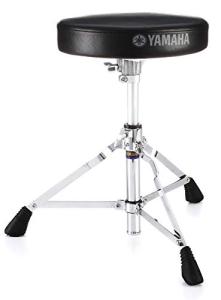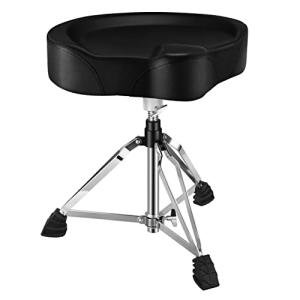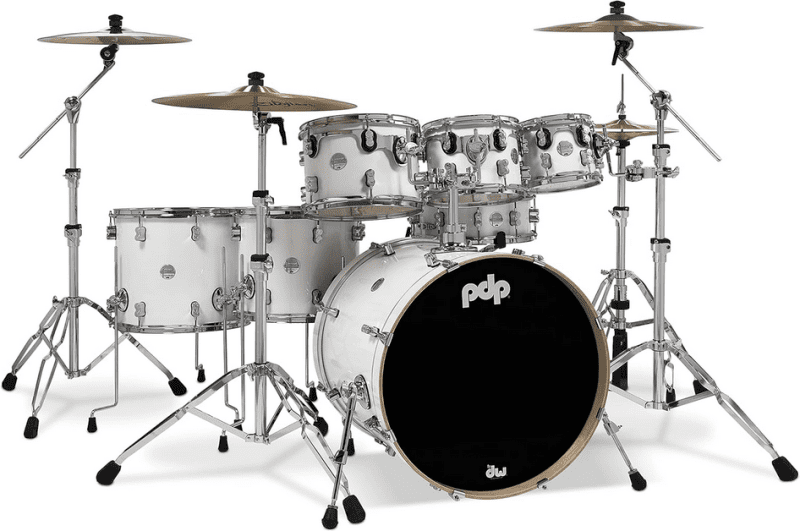Hey there, first-time drummers and newcomers! Drumming is thrilling, but mastering it starts with the basics. This guide will show you the top 10 essential skills for beginners. If you're ready to start your drumming journey, keep reading to learn the basics every drummer should know.

Key Takeaways
- Understand the proper grip and hand position for drumming
- Learn the basic drum strokes and rudiments
- Develop essential rhythmic patterns and time-keeping skills
- Explore dynamic control and coordination techniques
- Discover the secrets to mastering drum fills and solos
Mastering the Fundamentals
Before you start with complex rhythms, it's key to get the basics right in drumming. Your playing starts with how you hold your sticks and where your hands sit. Learning the right grip techniques and drumstick techniques helps avoid strain and boosts your drumming.
Grip and Hand Position
The drumming grip is vital. Drummers often use either the matched grip or the traditional grip. Getting these grip and hand position right sets a strong base for better drumming skills.
Basic Drum Strokes
Every drummer should get to know the four basic drum strokes: full stroke, down stroke, tap, and upstroke. These basic drum strokes are key to most drumming patterns. They help build the foundation for more complex drum rudiments.
| Stroke | Description |
|---|---|
| Full Stroke | The stick is raised high and then brought down with full force, producing a loud, resonant sound. |
| Down Stroke | The stick is brought down with a controlled, deliberate motion, creating a strong, accented note. |
| Tap | The stick is gently placed on the drum head, producing a soft, muted note. |
| Upstroke | The stick is lifted upward from the drum head, creating a light, airy note. |
Getting these basic drumstrokes right is crucial for a strong drumming foundation. It opens the door to more advanced skills.
https://youtube.com/watch?v=FstCw876T9M
"The key to becoming a great drummer is to master the fundamentals. Everything else will follow."
Essential Rhythmic Patterns
As a beginner drummer, it's key to get the hang of single and double-stroke rolls and basic drum beats and rhythms. These simple patterns are the base for more complex drumming. They help you build skills and improve coordination.
Single and Double Stroke Rolls
The single-stroke roll alternates right and left-hand strokes for a smooth rhythm. The double-stroke roll uses two strokes per hand, adding power to your playing. Practicing these drum rolls boosts your timekeeping and coordination exercises. This sets the stage for more advanced drumming patterns.
Basic Drum Beats and Rhythms
Starting with simple rock beats and basic drum beats builds confidence and sharpens time-keeping skills. Trying out different drum rhythms and basic drum beats and rhythms unlocks the secrets of essential beats and rhythms for new drummers.
| Drum Technique | Description | Benefits |
|---|---|---|
| Single Stroke Roll | Alternating right and left-hand strokes | Improves timekeeping and coordination |
| Double Stroke Roll | Two consecutive strokes per hand | Adds momentum and power to your playing |
| Basic Rock Beat | Simple, four-on-the-floor pattern | Builds confidence and time keeping skills |

"Mastering the basics of drumming, like single and double stroke rolls and basic drum beats, is key for beginners. These patterns are the foundation for complex techniques. They improve your coordination and timekeeping abilities."
Top 10 Drumming Techniques Every Drummer Should Master
As a skilled drummer, it's key to master a wide range of techniques. This will improve your skills and make your performance better. You'll need to learn everything from basic grip and strokes to complex rhythmic patterns and how to control your drumsticks. These top 10 techniques are vital for any drummer wanting to improve.
- Proper drumming grip and hand position: A solid, comfortable grip is crucial. Try out different grip styles like traditional and matched grip to see what suits you best.
- Basic drum strokes: Get the basics right with full, half, and tap strokes. This builds a strong technical foundation.
- Single and double stroke rolls: Mastering these will boost your timing, coordination, and independence.
- Drum beats and rhythms: Learn various common time signatures and groove patterns. This includes everything from rock to jazz and funk.
- Drum fills and solos: Be able to smoothly move from the groove to dynamic, expressive drum fills. This shows off your technical skill and creativity.
- The paradiddle: This basic rudiment is the base for many advanced techniques. It helps with double-stroke rolls and complex patterns.
- Drumstick techniques: Try advanced stick control. This includes grip techniques, ghost notes, accents, and flams. These add flair to your playing.
- Foot technique: Work on controlling your bass drum and hi-hat. This ensures consistent timekeeping and independence between your limbs.
- Cymbal techniques: Get good at striking, muting, and playing different cymbal patterns. This adds dynamics and texture to your drumming.
- Drumming exercises and practice routines: Have a disciplined practice plan. Include a mix of coordination exercises, timing drills, and rudimentary patterns to keep improving your skills.
By focusing on these top 10 techniques, you'll open up a world of musical expression and technical skills. You'll be able to adapt to any drumming style or genre. Keep practicing and experimenting with these skills, and you'll become a versatile and skilled drummer.
| Drumming Technique | Description | Key Benefits |
|---|---|---|
| Drumming Grip | Proper hand positioning and grip style | Comfort, control, and technique foundation |
| Drum Strokes | Full, half, and tap strokes | Develop basic techniques and control |
| Stroke Rolls | Single and double-stroke rolls | Enhance timing, coordination, and independence |
| Drum Beats and Rhythms | Mastering common time signatures and groove patterns | Versatility in different drumming styles |
| Drum Fills and Solos | Transitioning between groove and expressive fills | Showcase technical prowess and creativity |
"Mastering the fundamentals of drumming is the key to unlocking your full potential as a musician. Dedication to these essential techniques will transform your playing and open up endless creative possibilities."
Advanced Drumming Concepts
Drummers looking to improve often want to learn more rhythms and techniques. They focus on the paradiddle and how to make great drum fills and solos.
The Paradiddle
The paradiddle is a key pattern for drummers. It mixes single and double strokes for a unique sound. Learning it lets drummers add flair to their playing, make complex fills, and sound more expressive.
Practicing the paradiddle helps drummers improve their timing and hand speed. With time, it becomes easy to use in their playing. This opens up new ways to be creative.
Drum Fills and Solos
Drum fills and solos let drummers show off their skills and style. These parts are chances to leave the main beat, show off technical skills, and engage the audience with exciting playing.
To make great drum fills and solos, drummers need to know about rhythms, controlling dynamics, and using different techniques. Those who are good at this can mix complex rhythms, use different drums and cymbals well, and make the music more exciting.
Mastering the paradiddle and improving in drum fills and solos helps drummers express themselves more in music. They become true artists behind the drums.
Developing Your Style
Once you've mastered basic drumming techniques, it's time to create your unique style. Try out different rhythms, dynamics, and fills to find what makes you stand out. This will help you develop your sound.
Exploring various drumming styles is key. Use different hand techniques like the single-stroke roll, double-stroke roll, flam, and drag rudiment to make unique rhythms. The Moeller technique is great for improving dynamic control and speed development.
Practicing drum patterns and polyrhythms is also crucial. These complex rhythms add depth to your playing, making your drumming more interesting. Mastering stick control drills helps you play these patterns accurately.
Don't hesitate to try new drumming techniques for beginners and advanced drumming techniques as you get better. Experimenting with fill techniques and dynamics control can make your playing unique. This will help you develop a special groove mastery.

The journey of developing your drumming style never ends. Keep practicing, exploring, and being creative. This way, you'll reach your full potential as a drummer and create a sound that's all yours.
Conclusion
Starting your drumming journey is thrilling. With the "top 10 techniques, every new drummer should practice," you're set to improve. The secret to getting better is regular drumming exercises and drumstick techniques.
Building a solid base in drum fills, groove, grip techniques, drumming patterns, and timing exercises is key. This will help you improve your stick control, foot techniques, and cymbal techniques. Keep working on drum rudiments and practice routines. They are the foundation for amazing drum rolls, groove patterns, and perfect timekeeping.
The journey of a drummer never ends. Keep exploring drumming styles, try out ghost notes, accents, and time signatures. Work on your drumming grip, paradiddles, flams, grooves, and fills. Stay patient, embrace the challenges, and enjoy the foot technique, drumstick control, and rudimentary patterns. These are what make your drum beats and coordination exercises unique.
FAQ
What are the basic drum strokes every beginner should learn?
Beginners should learn four basic drum strokes: full stroke, down stroke, tap, and upstroke. These strokes are the key to learning more complex drumming skills.
How important is proper grip and hand position for drumming?
Holding drumsticks with the matched or traditional grip is key. It prevents strain and improves your control and technique.
What are the essential rhythmic patterns every drummer should know?
Every drummer must master single and double-stroke rolls. These patterns are the foundation for complex rhythms and grooves.
What are some basic drum beats and rhythms for beginners to practice?
Beginners should start with simple rock beats and rhythms. These help build confidence and coordination. They also improve your timing and groove.
What is a paradiddle, and why is it an important drumming technique?
A paradiddle combines single and double strokes. It's a key technique for advanced patterns and fills. Mastering it is vital for drumming technique and independence.
How can drummers develop their unique style?
After learning basic techniques, experiment with different rhythms, dynamics, and fills. This exploration will help you find your unique drumming style and sound.
DISCLAIMER
This document is provided for general information purposes only and should not be relied upon as providing legal advice, technical, or specific operational guidance to the reader, whether as to the practices described in the document or the applicable legal requirements and regulations. Percussion Pros. Com expressly disclaims any responsibility for liability arising from or related to the use or misuse of any information in this document.






